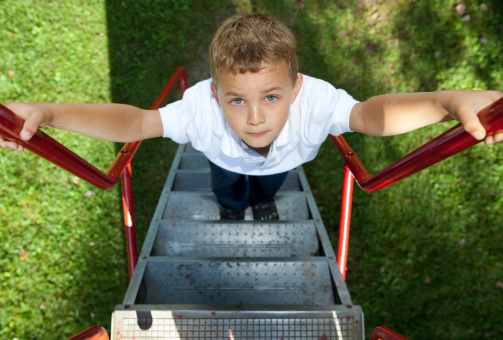Playground pitfalls and how to prevent them

Ahh, summertime— it’s the perfect time for kids to get outdoors and enjoy some fresh air. What better place to get those muscles moving than on the playground. It’s the perfect setting to help kids improve their dexterity, make friends and use their imaginations.
As much fun as playgrounds can be, there’s also a flip side to what they can bring—injuries. According to the Centers for Disease Control and Prevention (CDC), every year in the U.S., more than 156,000 children younger than age 14 are treated in hospital emergency rooms for injuries that happen on public playgrounds.
The CDC reports these playground injuries can range in severity from bumps and bruises to life-threatening injuries such as strangulation.
Dr. Nirav Shah, an orthopedic surgeon at Advocate Christ Medical Center in Oak Lawn, Ill., says during the summer he sees certain injuries more often due to playgrounds.
“We often see sprained ankles and broken bones in the forearm and knee injuries,” says Dr. Shah. “We also see injuries to growth plates in younger children, and in older children, such as 12-year-olds, we see ligament and cartilage injuries in the knees.”
The CDC reports that nearly 45 percent of playground injuries fall into the severe category. In addition to fractures and broken bones as Dr. Shah described, severe playground injuries include:
- Dislocations
- Concussions
- Internal injuries
- Amputations
Surface matters
Equipment, such as slides and swings, tends to be the greatest contributors to playground injuries, with falls being the largest cause. In fact, almost 79 percent of equipment-related injuries are caused by falls, according to the American Academy of Orthopaedic Surgeons (AAOS).
Playground injuries are preventable, and paying attention to playground surfaces can help, Dr. Shah says.
“Try to stick to playgrounds that have safe materials on the ground, so a lot of wood chips or a rubberized floor,” suggests Dr. Shah. “Stay away from cement or asphalt surfaces.”
Also avoid playground surfaces made of soil, packed dirt and grass as their shock absorption decreases with weather conditions and wear, he says.
Keep an eye out
Proper use of the playground also reduces risk of injury and this is reinforced through careful adult supervision, Dr. Shah says. “For example, consider a four- or five-year-old who’s on the monkey bars for the first time,” he says. “Make sure someone is there helping the child along. It’s easy to get distracted with other kids around so being observant of what’s going on is the best way to prevent playground injuries.”
AAOS also recommends the following guidelines for safe playground use:
- Steer children to equipment that’s age-appropriate.
- Avoid metal or wood swing seats; choose plastic or rubber ones.
- Make sure kids are clearly visible on the playground, with unobstructed views from their height.
- Remove rocks or any other tripping hazards.
Best way to respond
Despite everyone’s best efforts, accidents do still happen. If your child does suffer a playground injury, Dr. Shah encourages adults and caregivers to trust their instincts when trying to determine the best course of action when an injury occurs.
“Initially, a parent or caregiver can do a quick assessment by looking for any type of deformity. Ask yourself, ‘Does it look abnormal in terms of alignment?’ If so, call your doctor’s office or go to the ER,” says Dr. Shah.
For a lower body injury to the leg, hip knee or ankle, Dr. Shah says to determine if the child has difficulty walking or putting weight on the body part. If the child heard a “pop” or “crack,” then call your doctor or go to the ER.
“If the child is able to walk, but is limping, try ice or an over-the-counter pain reliever such as Tylenol or ibruprofen, and give it 24 hours,” he says. If it doesn’t improve, Dr. Shah recommends calling your doctor.
He also cautions parents to be particularly careful with open abrasions and scratches. “It’s important to make sure no fevers occur after a child gets an open cut, which may be a sign of bacterial infection. But fever won’t appear until 24 hours later so remember to check for fever during this period,” he says.
Related Posts
Comments
About the Author
health enews staff is a group of experienced writers from our Advocate Health Care and Aurora Health Care sites, which also includes freelance or intern writers.

















